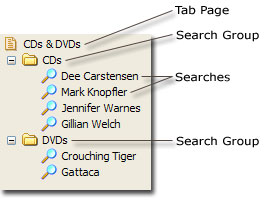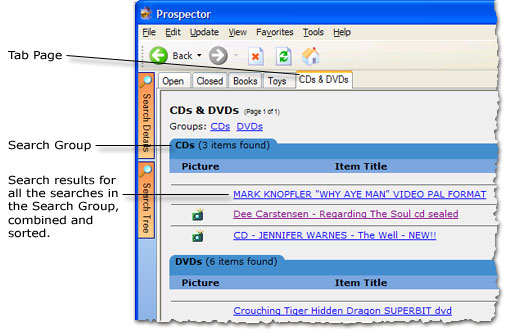In Prospector, you create a Search Tree to save your searches, and control how the you want to see your search results. The Search Tree is shown in a window titled My Saved Searches. By default, this is on the left side of the application.
The Search and Edit menus provide commands to let you build and manipulate the tree. You can also right-click within the Search Tree window to bring up a context menu.
For how a search tree is used, here's an example with saved searches for CDs and DVDs:

After replaying the searches, you can see the correspondence with the Search Tree:

A Search stores an eBay search, and the details are hidden behind a friendly name that you choose.
Search Groups let you to combine the results of searches.
Tab Pages are containers for Searches and Search Groups, and they are used to specify the order in which you want the results presented. Prospector will create a tabbed page containing a web browser for every Tab Page that you create.
With items stored in the Search Tree, you'll be able to see the latest results at any time by doing an Update.
When you update a Tab Page, Prospector will:
1. Make the searches on eBay for you.
2. Combine and sort the results in the Search Groups, if any.
3. Present the results as you want.
Possibilities
Saved searches give you easy search repeatability and consistency of searching.
Combining searches lets you see related items together. This can be very convenient, and you're now able to:
| · | Combine variants of your searches for prospecting. |
| · | Have each search in a group be very specific. |
| · | Easily monitor a market and have results presented as you like. |
| · | Use a group of searches as a shopping or wish list, and remove the individual searches as you obtain the items. |
| · | Create a group of alternatives, and remove the group when you're done. |
The search tree is flexible, and you're in control!